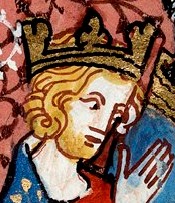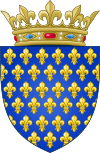Henry I of France
| Henry I | |
|---|---|
| King of the Franks (more...) | |
 A depiction of Henry from Chroniques de France ou de St Denis | |
| King of the Franks | |
| Junior king Senior king | 14 May 1027 – 20 July 1031; 20 July 1031 – 4 August 1060 |
| Coronation | 14 May 1027, Cathedral of Reims |
| Predecessor | Robert II |
| Successor | Philip I |
| Born | 4 May 1008 Reims, France |
| Died | 4 August 1060 (aged 52) Vitry-aux-Loges, France |
| Burial | Saint Denis Basilica, Paris, France |
| Spouse | Matilda of Frisia Anne of Kiev |
| Issue | Philip I Emma of France Robert of France Hugh I, Count of Vermandois |
| House | House of Capet |
| Father | Robert II |
| Mother | Constance of Arles |
| French Monarchy |
| Direct Capetians |
|---|
 |
| Hugh Capet |
| Robert II |
| Henry I |
| Philip I |
| Louis VI |
| Louis VII |
| Philip II |
| Louis VIII |
| Louis IX |
| Philip III |
| Philip IV |
| Louis X |
| John I |
| Philip V |
| Charles IV |
Henry I (4 May 1008 – 4 August 1060) was King of the Franks from 1031 to his death. The royal demesne of France reached its smallest size during his reign, and for this reason he is often seen as emblematic of the weakness of the early Capetians. This is not entirely agreed upon, however, as other historians regard him as a strong but realistic king, who was forced to conduct a policy mindful of the limitations of the French monarchy.
Reign
A member of the House of Capet, Henry was born in Reims, the son of King Robert II (972–1031) and Constance of Arles (986–1034).[1] He was crowned King of France at the Cathedral in Reims on 14 May 1027,[2] in the Capetian tradition, while his father still lived. He had little influence and power until he became sole ruler on his father's death.
The reign of Henry I, like those of his predecessors, was marked by territorial struggles. Initially, he joined his brother Robert, with the support of their mother, in a revolt against his father (1025). His mother, however, supported Robert as heir to the old king, on whose death Henry was left to deal with his rebel sibling.[3] In 1032, he placated his brother by giving him the duchy of Burgundy[3] which his father had given him in 1016.
In an early strategic move, Henry came to the rescue of his very young nephew-in-law, the newly appointed Duke William of Normandy (who would go on to become William the Conqueror), to suppress a revolt by William's vassals. In 1047, Henry secured the dukedom for William in their decisive victory over the vassals at the Battle of Val-ès-Dunes near Caen;[4] however, Henry would later support the barons against William until the former's death in 1060.[5]
In 1051, William married Matilda, the daughter of the count of Flanders, which Henry saw as a threat to his throne.[6] In 1054, and again in 1057, Henry invaded Normandy, but on both occasions he was defeated.[6]
Henry had three meetings with Henry III, Holy Roman Emperor—all at Ivois. In early 1043, he met him to discuss the marriage of the emperor with Agnes of Poitou, the daughter of Henry's vassal.[7] In October 1048, the two Henries met again and signed a treaty of friendship.[8] The final meeting took place in May 1056 and concerned disputes over Theobald III and County of Blois.[8] The debate over the duchy became so heated that Henry accused the emperor of breach of contract and subsequently left.[8] In 1058, Henry was selling bishoprics and abbacies, ignoring the accusations of simony and tyranny by the Papal legate Cardinal Humbert.[9] Despite his efforts, Henry I's twenty-nine-year reign saw feudal power in France reach its pinnacle.
King Henry I died on 4 August 1060 in Vitry-en-Brie, France, and was interred in Basilica of St Denis. He was succeeded by his son, Philip I of France, who was 7 at the time of his death; for six years Henry's queen Anne of Kiev ruled as regent.
He was also Duke of Burgundy from 1016 to 1032, when he abdicated the duchy to his brother Robert.[10]
Marriages
Henry I was betrothed to Matilda, the daughter of Conrad II, Holy Roman Emperor, but she died prematurely in 1034.[11] Henry then married Matilda of Frisia, but she died in 1044,[12] following a Caesarean section. Casting further afield in search of a third wife, Henry married Anne of Kiev on 19 May 1051.[12] They had four children:
- Philip I (23 May 1052 – 30 July 1108).
- Emma (1054 – 1109?).
- Robert (c. 1055 – c. 1060).
- Hugh "the Great" of Vermandois (1057–1102).[13]
Ancestry
| Family of Henry I of France | ||||||||||||||||||||||||||||||||||||||||||||||||||||||||||||||||||||||||||||||||||||||||||||||||||||||||||||||||||||||||||||||||||||||||||||||||||||||||||||||||||||||||||||||||||||||||||||||||||||||||||||||||||||||||||||||||||||||||||||||||||||||||||||||||||||||||||||||||||||||||||||||||||||||||||||||||||||||||||||||||||||||||||||||||||||||||||||||||||||||||||||||||||||||||||||||||||||||||||||||||||||||||||||||||||||||||||||||||||||||||||||||||||||||||||||||||||||||||||||||||||||||||||||||||||||||||||||||||||||||||||||||||||||||||||||||||||||||||||||||||||||||||||||||||||||||||||||||||
|---|---|---|---|---|---|---|---|---|---|---|---|---|---|---|---|---|---|---|---|---|---|---|---|---|---|---|---|---|---|---|---|---|---|---|---|---|---|---|---|---|---|---|---|---|---|---|---|---|---|---|---|---|---|---|---|---|---|---|---|---|---|---|---|---|---|---|---|---|---|---|---|---|---|---|---|---|---|---|---|---|---|---|---|---|---|---|---|---|---|---|---|---|---|---|---|---|---|---|---|---|---|---|---|---|---|---|---|---|---|---|---|---|---|---|---|---|---|---|---|---|---|---|---|---|---|---|---|---|---|---|---|---|---|---|---|---|---|---|---|---|---|---|---|---|---|---|---|---|---|---|---|---|---|---|---|---|---|---|---|---|---|---|---|---|---|---|---|---|---|---|---|---|---|---|---|---|---|---|---|---|---|---|---|---|---|---|---|---|---|---|---|---|---|---|---|---|---|---|---|---|---|---|---|---|---|---|---|---|---|---|---|---|---|---|---|---|---|---|---|---|---|---|---|---|---|---|---|---|---|---|---|---|---|---|---|---|---|---|---|---|---|---|---|---|---|---|---|---|---|---|---|---|---|---|---|---|---|---|---|---|---|---|---|---|---|---|---|---|---|---|---|---|---|---|---|---|---|---|---|---|---|---|---|---|---|---|---|---|---|---|---|---|---|---|---|---|---|---|---|---|---|---|---|---|---|---|---|---|---|---|---|---|---|---|---|---|---|---|---|---|---|---|---|---|---|---|---|---|---|---|---|---|---|---|---|---|---|---|---|---|---|---|---|---|---|---|---|---|---|---|---|---|---|---|---|---|---|---|---|---|---|---|---|---|---|---|---|---|---|---|---|---|---|---|---|---|---|---|---|---|---|---|---|---|---|---|---|---|---|---|---|---|---|---|---|---|---|---|---|---|---|---|---|---|---|---|---|---|---|---|---|---|---|---|---|---|---|---|---|---|---|---|---|---|---|---|---|---|---|---|---|---|---|---|---|---|---|---|---|---|---|---|---|---|---|---|---|---|---|---|---|---|---|---|---|---|---|---|---|---|---|---|---|---|---|---|---|---|---|---|---|---|---|---|---|---|---|---|---|---|---|---|---|---|---|---|---|---|---|---|---|---|---|---|---|---|---|---|---|---|---|---|---|---|---|---|---|---|---|---|---|---|---|---|---|---|---|---|---|---|---|---|---|---|---|---|---|---|---|---|---|---|---|---|---|---|---|---|---|---|---|---|---|---|---|---|---|---|---|---|---|---|---|---|---|---|---|---|---|---|---|---|---|---|---|---|---|---|---|---|---|---|---|---|---|---|---|---|---|---|---|---|---|---|---|---|---|---|---|---|---|---|
| ||||||||||||||||||||||||||||||||||||||||||||||||||||||||||||||||||||||||||||||||||||||||||||||||||||||||||||||||||||||||||||||||||||||||||||||||||||||||||||||||||||||||||||||||||||||||||||||||||||||||||||||||||||||||||||||||||||||||||||||||||||||||||||||||||||||||||||||||||||||||||||||||||||||||||||||||||||||||||||||||||||||||||||||||||||||||||||||||||||||||||||||||||||||||||||||||||||||||||||||||||||||||||||||||||||||||||||||||||||||||||||||||||||||||||||||||||||||||||||||||||||||||||||||||||||||||||||||||||||||||||||||||||||||||||||||||||||||||||||||||||||||||||||||||||||||||||||||||
References
- ^ Jim Bradbury, The Capetians: The History of a Dynasty, (Bloomsbury, 2007), 93.
- ^ William W. Clark, Medieval Cathedrals, (Greenwood Publishing, 2006), 87.
- ^ a b Elizabeth Hallam and Judith Everard, Capetian France 987-1328, (Routledge, 2013), 95.
- ^ David C Douglas, William the Conqueror, (Yale University Press, 1999), 1026.
- ^ R. Allen Brown, The Normans and the Norman Conquest, (Boydell Press, 1969), 49.
- ^ a b Jim Bradbury, The Capetians: The History of a Dynasty, 106-108.
- ^ {DE}Frauen und Tochter der salischen Herrsher, Zum Wandel salischer Hieratspolitik in der Krise, Claudia Zey, Die Salier, das Reich und der Niederrhein, ed. Tilman Struve, (Bohlau Verlag GmbH & Cie., 2008), 62.
- ^ a b c Stefan Weinfurter, The Salian Century: Main Currents in an Age of Transition, (University of Pennsylvania Press, 1999), 107.
- ^ Elizabeth Hallam, The Capetians 987-1328, (Longman Group Ltd., 1980), 104.
- ^ Jim Bradbury, The Capetians: The History of a Dynasty, 100.
- ^ Herwig Wolfram, Conrad II, 990-1039: Emperor of Three Kingdoms, transl. Denise A Kaiser, (The Pennsylvania State University Press, 2000), 38.
- ^ a b Jim Bradbury, The Capetians: The History of a Dynasty, 108-109.
- ^ Gislebertus (of Mons), Chronicle of Hainaut, transl. Laura Napran, (The Boydell Press, 2005), 28 note108.
- ^ Settipani, Christian (2000). "Les vicomtes de Châteaudun et leurs alliés". Onomastique et Parenté dans l'Occident médiéval (in French). Oxford: Prosopographica et genealogica. pp. 247–261. ISBN 1-900934-01-9.
{{cite news}}: Unknown parameter|trans_title=ignored (|trans-title=suggested) (help) - ^ Christian Settipani, "Les comtes d'Anjou et leur alliances aux Xe et XIe siècles", in K. S. B. Keats-Rohan, ed., Family Trees and the Roots of Politics (Woodbridge, Suffolk, 1997): 211–267.
Sources
- Vajay, S. Mathilde, reine de France inconnue (Journal des savants), 1971.
